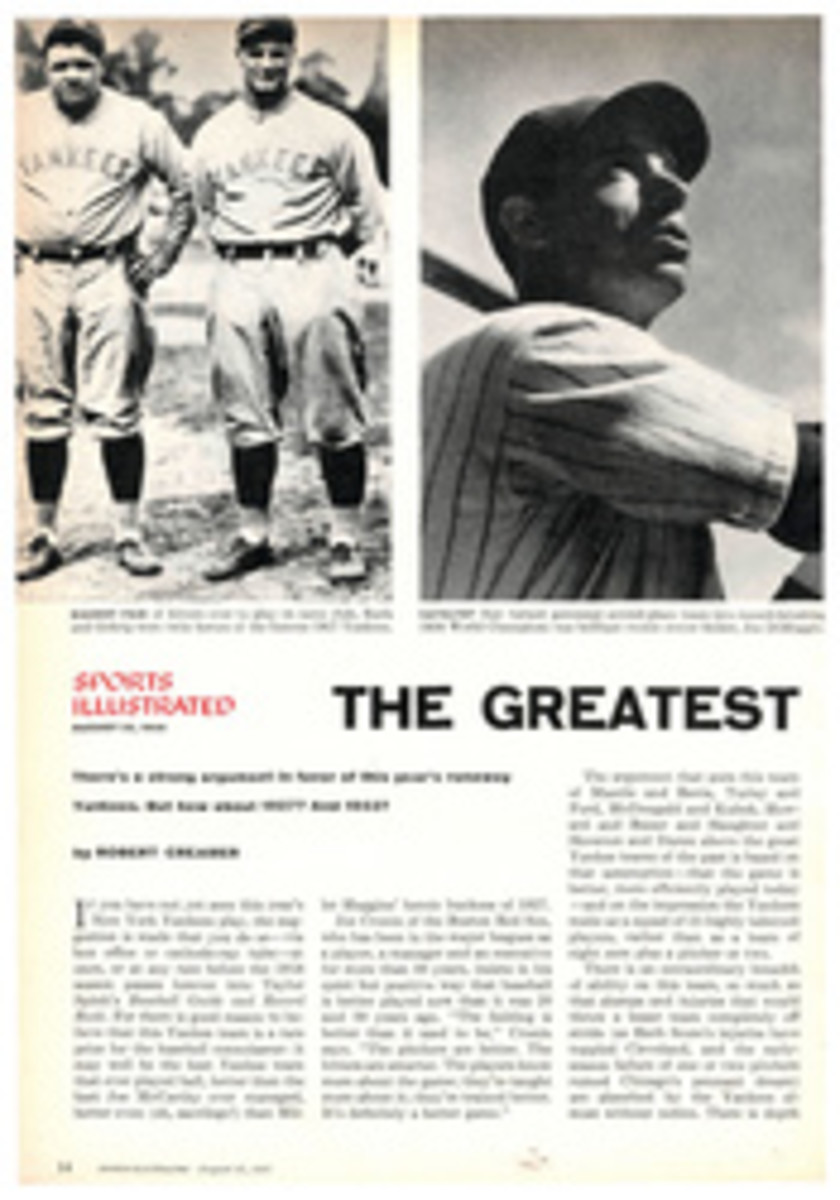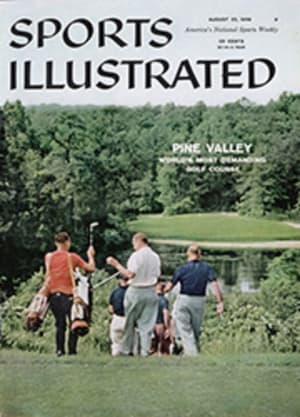
The inequitable equalizer
This criticism ofUSGA handicapping comes from a former Walker Cup team member. He is currentlychairman of the handicap committee of the Palmetto Golf Club in Aiken, S.C.,where he makes his home. The author's literary credentials stem fromGreat-Grandfather Henry Wadsworth Longfellow.
One of thereasons golf has become so popular in the U.S. these last few years is thatregardless of his ability a player can compete on an even basis with someonewho is far more proficient at the game than he is. For instance, with theproper handicap two weekend players of average ability can compete against BenHogan and Sam Snead. Provided the stroke allowances are correct, they will havea good chance of winning if they do not become overawed by Ben's and Sam'stremendous power but just play their own games. After his wife and children,the most important thing in life to the ardent amateur golfer is his handicap.He devours many valuable hours thinking up devious strategies to get itincreased by his club's handicap committee.
The U.S. GolfAssociation has devised and perfected through the years a very fine system ofhandicapping. If faithfully followed, it will result in equitable handicappingthroughout the entire country. I feel there is only one thing seriously wrongwith it. The USGA system is predicated on individual stroke play scoring,whereas 95% of the tournament golf played by the average middle-tohigh-handicap golfer is either with a professional partner in a pro-amateurevent or with an amateur partner in the very popular member-guest handicapfour-ball type of competition.
To bestunderstand the shortcomings of the USGA system, let us take the case of Mr. Aand Mr. B. Mr. A is a man of slight build in his early 60s and has been playinggolf for more than 40 years. Now that he is retired he plays more regularlythan ever, but due to his slight physique he is unable to hit the ball veryfar; in fact, except for the few short holes on his course he usually mustone-putt in order to get his par. However, his very accurate short gamecompensates somewhat for his lack of length. His drive, what there is of it,never fails to land on the fairway. There is a saying at his club that he hasnot lost a ball since the days of the gutty. His 10 lowest rounds of his last25 average 85, and so, under the USGA system, he is entitled to a handicap of11.
LONGER BUTWILDER
Mr. B, a memberof the same club, was a varsity athlete during his college days. He never hadtime for golf until he reached his middle 30s and became a partner in a firm onWall Street. He plays once a week during the summer and has little or no timefor practice. Nevertheless, the timing, coordination and physical strength hedeveloped as a college athlete stand him in good stead on the golf course. Hehas a tremendous tee-shot that is the envy of all the low-handicap golfers inthe club. On occasion he has outdriven some of the touring professionals.Naturally, he is quite proud of his long drives and likes to display hisprowess on every possible hole. This causes him to lose quite a few balls andto pick up on several holes each round. Mr. B's putting is well above average,since he has a good eye and is a natural competitor. Following the USGA systemof allowing only double bogies for holes he picked up on, his 10 best scores ofhis last 25 are comparable to Mr. A's, giving him a handicap of 11 also.
Both Mr. A andMr. B recently entered a pro-amateur event at their club, where par on thefirst nine holes is 36. Given 85% of their handicap as suggested by the USGA,each was allowed five strokes on the first nine (see chart on following page).Mr. A took a 42 going out, giving his pro partner eight pars but no birdieswhen his handicap was deducted. His pro, who happened to be one of the leadingmoney winners on the tour, was out in 34 on his own ball. Mr. A was obviouslyof little help.
Mr. B, who wasalso fortunate to have a crack professional as his partner, went out in 42 justas Mr. A had done, but he picked up on four holes. Adhering to the USGAprocedure, I have given him double bogies on the holes where he picked up. Onthe other five holes he gave his professional partner four birdies and oneeagle with the aid of his handicap strokes. His pro partner managed to par allthe holes for a 36 so together they had a net best-ball of 30, whereas poor Mr.A was unable to improve on his partner's 34. It is not hard to see why Mr. A'spro was telling Mr. B's pro what a lucky stiff he was.
In the club'sannual member-guest handicap four-ball, Mr. A invites his old crony Mr. C to behis partner. Mr. C has the same handicap and plays the same type of game as Mr.A. After qualifying they are drawn for match play against Mr. B and his oldcollege classmate, Mr. D, who is the same type of player as Mr. B. As sometimeshappens in golf, Mr. A and Mr. B shot the exact score, hole by hole, that theyhad in the pro-amateur. Mr. C, with the same number of strokes as Mr. A, helpedhim on three holes. He holed a good putt for his 4 at the first, made a finepar at the 3rd and salvaged a gross 5 at the 9th.
This gave Mr. Aand Mr. C a net best-ball going out of 34. Mr. D, who is as erratic as Mr. Band who had just returned from a business trip to California, had hard goingthe first nine. With the aid of a chip-in he was able to make only two pars—onthe 2nd and 3rd holes—and for the remainder of the nine he was in his pocket.However, he figured in the very two holes that Mr. B was out of play. This gavethem a net best-ball of 33, which in match play put them 3 up on Mr. A and hispartner, Mr. C (see chart).
The handicappingsystem I would like to suggest would be used only in pro-amateur and handicapfour-ball play as follows. The handicap scale would range from 0 to 18, as itis not usual to give a player in partnership play more than one stroke per holeor to make a scratch amateur compete with a minus handicap. In order todetermine the correct handicap you would average the number of pars and birdiesmade by the player in his previous 10 rounds. Starting with 18 points, a playerwould be docked one point for every par and two points for each birdie. Mr. A,our short-hitting friend, averages seven pars per round, so his handicap wouldremain the same as under the USGA system: 11. Mr. B, on the other hand,averages six pars and two birdies giving him a total of 10 points per round.This would lower his handicap to eight.
Under my system,the player's full handicap is always used. On this basis, Mr. A in thepro-amateur would have given his professional partner one net birdie and sevenpars for a best-ball of 33 instead of 34. Mr. B with eight strokes would havestill helped his pro with four net birdies and one eagle, with no change intheir best-ball of 30. This does not make Mr. A and Mr. B even, but it helps tonarrow the gap.
In themember-guest event, Mr. C being a comparable player to Mr. A has the samehandicap under my system, but since they receive their full 11 strokes, theirnet best-ball is now 33. Mr. D, who averages the same number of pars andbirdies as Mr. B, also has his handicap reduced to eight. Now their netbest-ball has become 34. But they are, in match play, only 1 up on Mr. A andMr. C, instead of 3 up.
The heart andsoul of stroke play is consistency. Consistency plays little part in four-ball,best-ball play. Why, then, use a stroke play yardstick to determine a golfer'smatch-play handicap? When you have a steady partner and you have a goodhandicap it's not what you score but the birdies and eagles you shoot that winthe match for your side.
Only oneadjustment is necessary to make the system uniform throughout the country; forthose who play regularly on a course that is under 6,200 yards, deduct twopoints from the score of birdies and pars; for those who play on a course inexcess of 6,700 yards, add two points.
[This articlecontains a table. Please see hardcopy of magazine or PDF.]
PHOTO
KNOWLES, 44, IS STILL A FINE GOLFER

